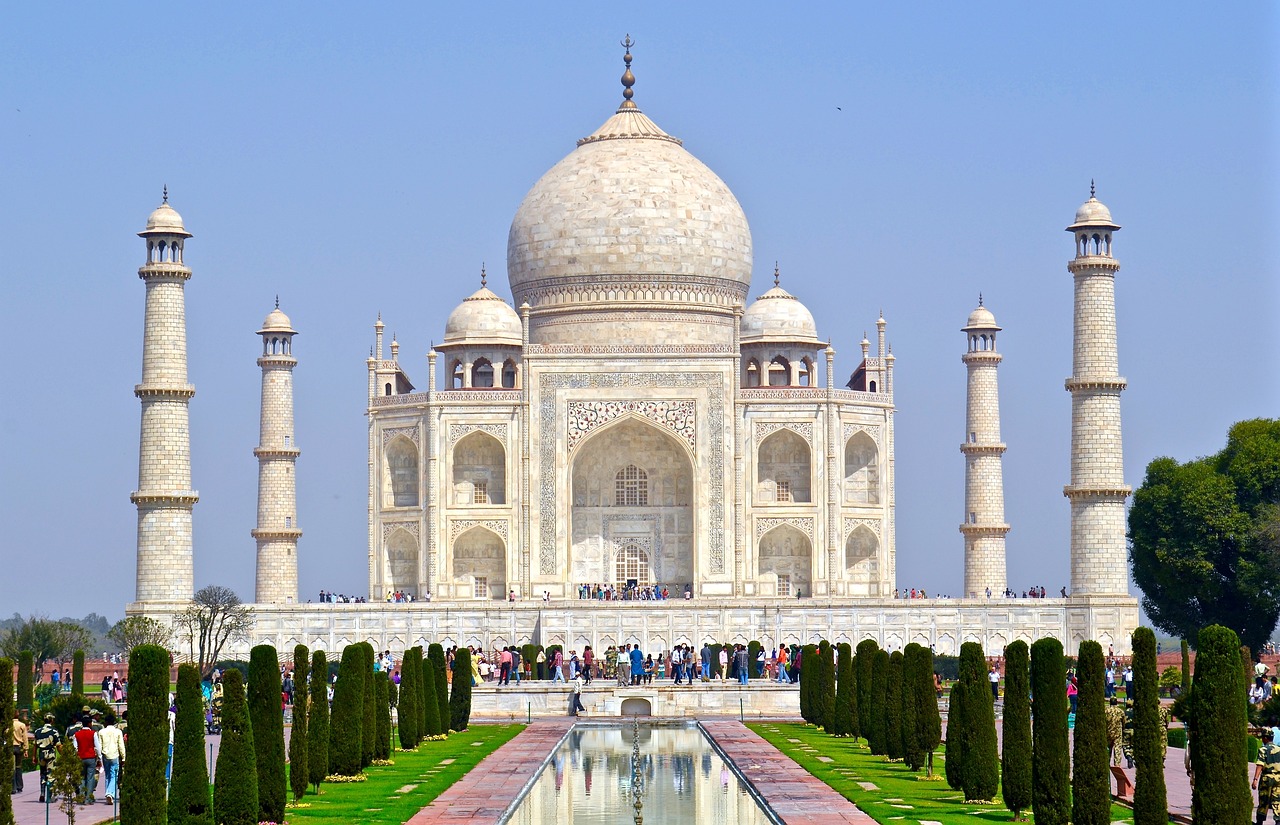The Taj Mahal situated in the city of Agra,
Uttar Pradesh, this majestic mausoleum is a UNESCO World Heritage Site and one of the New Seven Wonders of the World. Its exquisite beauty and historical significance draw millions of visitors from across the globe each year, making it a symbol of enduring love and architectural marvel.

**History and Origin**
Commissioned in 1632 by the Mughal emperor Shah Jahan, the Taj Mahal was built in memory of his beloved wife, Mumtaz Mahal, who died during childbirth. Designed by architect Ustad Ahmad Lahauri, the construction of this magnificent structure took over two decades to complete and involved the labor of thousands of skilled artisans and craftsmen from various parts of the world.
**Architectural Splendor**
The Taj Mahal is renowned for its symmetrical design and meticulous craftsmanship. Constructed primarily of white marble sourced from Rajasthan, the mausoleum features intricate carvings, inlaid precious and semi-precious stones, and delicate filigree work. Its central dome, flanked by four smaller domed chattris (pavilions), is a striking example of Persian and Mughal architectural styles.

The garden surrounding the Taj Mahal is a marvel in itself, with meticulously manicured lawns, serene reflecting pools, and lush greenery. The layout of the garden, divided into four quadrants by water channels, symbolizes the paradise described in Islamic literature.
**Symbolism and Meaning**
Beyond its architectural grandeur, the Taj Mahal holds deep symbolic significance. It is often regarded as a symbol of eternal love, with Shah Jahan's extravagant tribute to his wife serving as a timeless testament to the power of love and devotion. The intricate designs and inscriptions adorning the walls of the mausoleum are laden with symbolism, reflecting themes of paradise, eternity, and spiritual transcendence.
**Cultural Significance**
The Taj Mahal is not just a monument; it is a living symbol of India's rich cultural heritage and a source of national pride. Its inclusion on the UNESCO World Heritage List has helped preserve and safeguard its legacy for future generations. Moreover, the site serves as a pilgrimage destination for people of all faiths, transcending religious and cultural boundaries.
**Challenges and Preservation Efforts**
Despite its enduring beauty, the Taj Mahal faces numerous challenges, including environmental pollution, urban encroachment, and natural wear and tear. Air pollution from nearby industries and vehicular traffic has led to the discoloration of the marble façade, posing a significant threat to the monument's integrity.
In response to these challenges, various preservation efforts have been undertaken by the Indian government and international organizations. Measures such as restricting vehicular traffic around the monument, promoting eco-friendly tourism practices, and implementing conservation projects to clean and restore the marble have been initiated to ensure the long-term sustainability of the Taj Mahal.
**Visitor Experience**
Visiting the Taj Mahal is a transformative experience that leaves a lasting impression on all who behold its beauty. As visitors approach the monument, they are greeted by the breathtaking sight of the gleaming white marble edifice set against the backdrop of the clear blue sky. Walking through the intricately carved gateways and across the expansive gardens, one is transported back in time to an era of opulence and splendor.
Inside the mausoleum, the atmosphere is serene and reverential, with shafts of sunlight streaming through the ornate marble lattice screens. The cenotaphs of Shah Jahan and Mumtaz Mahal, adorned with intricate floral motifs and calligraphy, serve as a poignant reminder of the enduring power of love.
**Conclusion**
In conclusion, the Taj Mahal stands as a timeless testament to the enduring power of love, beauty, and human creativity. Its architectural splendor, cultural significance, and historical legacy continue to inspire awe and admiration in people from all walks of life. As we marvel at its magnificence, let us also commit to preserving and protecting this iconic symbol of India's rich heritage for generations to come.



You must be logged in to post a comment.